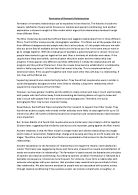Theories of Love Essay
Sternberg (1986) presents a triangular theory of love, consisting of three components that define love: commitment, passion and intimacy. A successful relationship – entitled ‘consumate love’ – consists of all three of these components. However a singular component can feature in a relationship, commitment alone being called ‘empty love’, intimacy alone is a liking or a friendship, and passion alone is seen as infatuation. Sternberg also displays that the absence of one of these components would create a type of love different to ‘consumate love’. Passion and intimacy in a relationship causes ‘romantic love’, as they are a combination of infatuation and liking, with the absence of commitment. Passion and commitment would be considered ‘fatuous love’ with the absence of intimacy. Commitment and intimacy causes ‘companionate love’, as there is an absence of passion. Simply, the triangular theory of love argues that there are different types of love, and they are built upon commitment, intimacy and passion.







